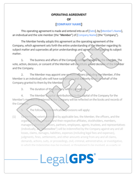What to Do When You Discover an Employee is Secretly Working for a Competitor
You’re scrolling through LinkedIn when you spot a post: your top salesperson, still on your payroll, is boasting about their new role at a rival...
5 min read
LegalGPS : Sep. 25, 2025
You’re sipping coffee when an employee confesses: they accidentally emailed a spreadsheet with client Social Security numbers to the wrong recipient. Panic sets in—data breaches can lead to fines up to $2,500 per violation under laws like CCPA, lawsuits costing $10,000–$100,000, and a tarnished reputation. An employee’s mistake with sensitive data is a crisis that demands swift action to contain damage and comply with regulations.


Legal GPS Pro
Protect your business with our complete legal subscription service, designed by top startup attorneys.
This guide walks you through how to handle an employee accidentally emailing sensitive data, offering a clear, actionable plan to contain the breach, meet legal obligations, and prevent recurrence. From assessing the leak to strengthening security, we’ll cover five key steps, packed with real-world examples and practical “Pro Tips” to protect your business. Whether you’re a startup founder, small business owner, or freelancer with staff, let’s secure your data.

Employee Confidentiality Agreement
Safeguard sensitive company info with a comprehensive Employee Confidentiality Agreement. Discover key terms and enforceability tips.
Trusted by 1,000+ businesses to safeguard their LLCs.
Your first step is to evaluate the severity of the data leak to understand its risks and legal implications.
Identify the data sent: client names, financial details, or protected info like SSNs or health records. Confirm the recipient—was it an external party or an internal misaddress? Check the email’s status: was it opened, forwarded, or intercepted? Use your email system’s tracking (e.g., Outlook logs) to verify. Review data breach laws, like GDPR (if serving EU clients) or CCPA (in California), which may require notifications for leaks of personal data.
Document findings in a Google Sheets file: data type, recipient, date sent, and applicable laws. This helps you prioritize actions and prepare for compliance. The Federal Trade Commission offers data breach guidance to understand your obligations.
Mike, an agency owner, learned an employee emailed client financial data to a wrong external address. He confirmed the spreadsheet contained names and bank details for 50 clients, not opened by the recipient. Mike noted CCPA applied, requiring notification, and saved details in a spreadsheet. His assessment guided his response.
Assessing the breach, as Mike did, ensures you act based on facts, minimizing risks and meeting legal requirements.
Use a Google Docs checklist: “Data type? Recipient? Laws (CCPA/GDPR)? Email status?” Review it within 2 hours of discovery to capture details accurately. This structured approach speeds up your response and ensures compliance with notification laws.
Act fast to limit the leak’s damage and prevent further exposure of sensitive data.
If your email system (e.g., Gmail, Outlook) allows, recall the email within minutes—success rates drop after 30 minutes. If recall fails, contact the recipient via phone or email, politely requesting they delete the email without opening or sharing it. Suspend the employee’s email access temporarily via Okta ($8/user/month) to prevent further errors. Notify your IT team to secure affected systems, like changing database passwords or locking client records.
Document actions: note recall attempts, recipient communications, and IT changes in Google Drive. Confirm the data is contained before proceeding.
Enable email recall in Gmail (set “Undo Send” to 30 seconds) or Outlook for quick retractions. Train staff to report errors within 5 minutes to maximize recall success, reducing breach risks without external contact.
Containment limits the breach’s scope, protecting your clients and business from further harm.
Data breach laws often require notifying affected clients and authorities, so act promptly to comply and maintain trust.
Draft a notification letter for affected clients, stating what data was leaked, when, and steps taken (e.g., “We’ve secured systems”). Offer remedies, like free credit monitoring ($10–$20/month via Experian). Send within 72 hours if required by CCPA or GDPR. Report to authorities, like your state’s Attorney General or the FTC, if the breach exceeds thresholds (e.g., 500+ records in California). Use templates from your state’s website.
Consult a lawyer ($200–$500) to ensure notifications are compliant and save copies in Google Drive. Track delivery via email or certified mail ($4–$8).
Laura, a startup founder, had an employee email 100 client SSNs to a wrong address. She sent a notification letter within 48 hours, offering credit monitoring, and reported to the California AG per CCPA. Her lawyer reviewed the letter, ensuring compliance. Laura’s quick response maintained client trust.
Notifications, like Laura’s, meet legal requirements and show clients you’re proactive, reducing fallout.
Draft a Google Docs breach notification template: “On [date], [data] was sent to [recipient]. We’ve [actions]. Contact [number] for help.” Customize it for each incident to save time, ensuring compliance with state or federal laws while maintaining professionalism.
Address the employee’s mistake fairly to understand the cause and prevent recurrence, while maintaining workplace morale.
Interview the employee privately with an HR witness, asking, “What happened? Was it intentional?” Most errors stem from carelessness, like mistyping an email address, not malice. Review their training records to check prior data handling education. Issue discipline based on intent: a written warning for first-time errors or termination for repeated negligence.
Document the investigation: interview notes, discipline issued, and retraining plans in Google Drive. Have the employee sign an acknowledgment of the discussion.
Use a Google Docs incident report template: “Date, employee, data leaked, cause, discipline.” Complete it within 24 hours of the interview to ensure accuracy. This record supports compliance audits and defends against wrongful termination claims.
Fair discipline corrects behavior without alienating staff, fostering accountability.
A data leak is a wake-up call to bolster security measures and prevent future incidents.
Implement email encryption via Gmail (Google Workspace, $6/user/month) or ProtonMail ($5/month) for sensitive communications. Restrict access to sensitive data using Okta, limiting it to essential staff. Train employees every 6 months on data handling—cover email safety and phishing using free FTC resources. Conduct quarterly security audits with tools like Nessus ($2,000/year) to identify risks.
Update your data security policy: “All client data must be encrypted; report errors within 1 hour.”
Tom, a retailer, faced a data leak when an employee emailed client credit card info incorrectly. He added Gmail encryption, trained staff quarterly, and ran Nessus audits. His updated policy required error reports within 1 hour. Tom’s measures prevented further leaks, boosting customer confidence.
Strong policies, like Tom’s, create a secure environment, protecting your business long-term.
Install DLP tools like Symantec ($10/user/month) to flag sensitive data in outgoing emails, like SSNs. Configure alerts for HR review before sending, catching errors in real time and reducing breach risks.
An employee accidentally emailing sensitive data is a crisis, but with the right response, you can contain it and strengthen your business. By assessing the breach, containing it, notifying parties, investigating the employee, and enhancing security, you’ll protect your clients and reputation. Start today by reviewing your data security protocols—preparation is your best defense.
Have you faced a data breach or worry about leaks? Share your story in the comments or reach out. Your business deserves ironclad security—let’s keep it safe.
The biggest question now is, "Do you need a lawyer for your business?” For most businesses and in most cases, you don't need a lawyer to start your business. Instead, many business owners rely on Legal GPS Pro to help with legal issues.
Legal GPS Pro is your All-In-One Legal Toolkit for Businesses. Developed by top startup attorneys, Pro gives you access to 100+ expertly crafted templates including operating agreements, NDAs, and service agreements, and an interactive platform. All designed to protect your company and set it up for lasting success.

Legal GPS Pro
Protect your business with our complete legal subscription service, designed by top startup attorneys.
|
Premium Template
Single-use Template |
Legal GPS Pro
Unlimited Access, Best Value |
|
|
| Choose Template | Learn More |
| Trusted by 1000+ businesses | |

You’re scrolling through LinkedIn when you spot a post: your top salesperson, still on your payroll, is boasting about their new role at a rival...

You run a small retail store, and an employee’s chronic underperformance—missed shifts, customer complaints—is dragging down your team. You’re ready...

You’re running a small retail store when a trusted employee approaches you, requesting leave under the Family and Medical Leave Act (FMLA) for a...